ASUS Zenbook Prime (UX21A) Review: The First of the 2nd Gen Ultrabooks
by Anand Lal Shimpi on May 22, 2012 2:46 PM EST- Posted in
- Laptops
- CPUs
- Asus
- Ivy Bridge
- Zenbook
- Zenbook Prime
- Ultrabook
- Notebooks
The Display in Numbers
The new 1080p panel looks good, but does it make any sacrifices in its performance? Thankfully, no. Max brightness is down a bit compared to the previous generation, but it's still higher than any of the portable Macs and much higher than your typical PC displays. Black levels are much improved over the original Zenbook as well:
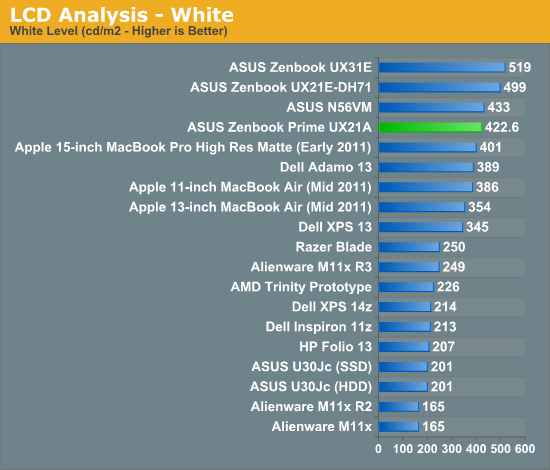
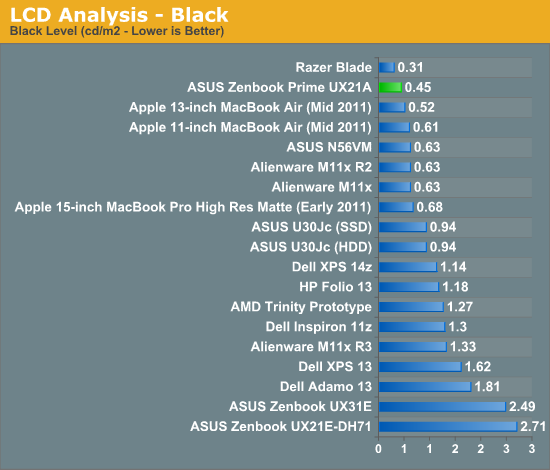
The resulting contrast ratio is almost tablet-like:
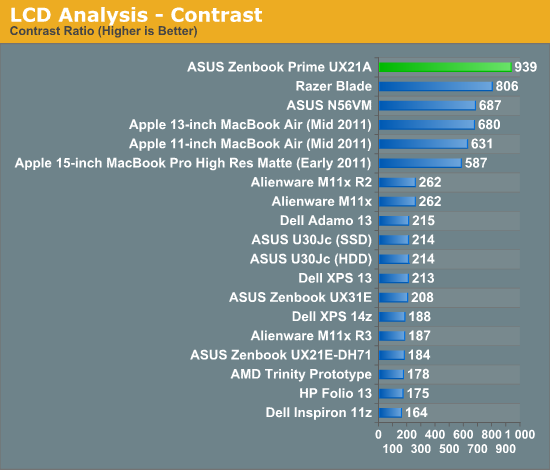
It's not just the basics that ASUS delivers well on, color accuracy is top notch:
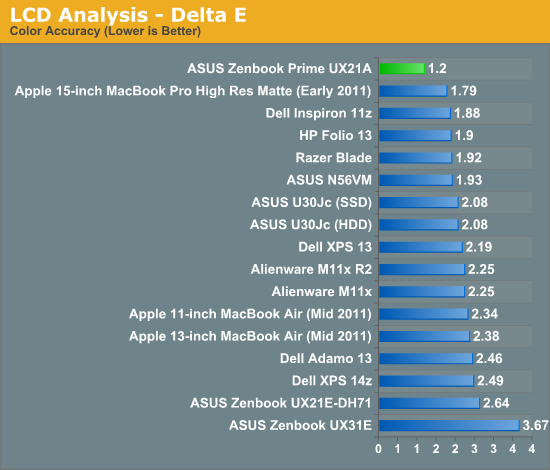
Color gamut is shy of the MacBook Pro but much better than the previous Zenbook and the MacBook Air:
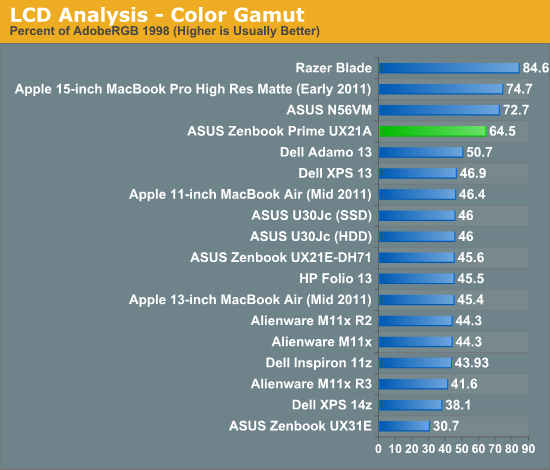
Size is definitely an issue here. While I think the 1920 x 1080 panel will be a very good fit for the 13.3-inch UX31, there's a smaller subset of folks who are going to appreciate it in the 11.6-inch UX21. Personally I think it's fine but at 189 PPI the 11-inch Zenbook Prime is going to be a tough sell for those who have a tough time looking at small text.
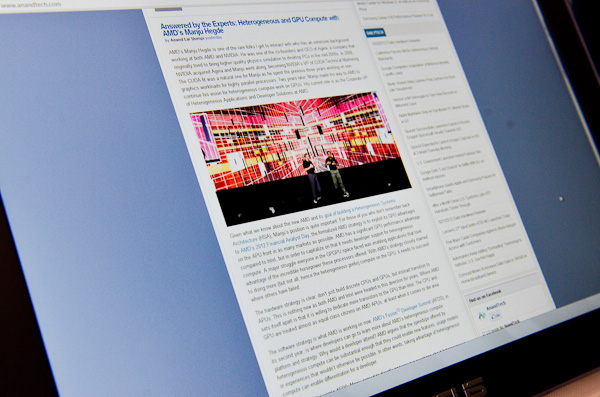
Text on the 11-inch 1080p panel
ASUS' solution is to ship the UX21 with Windows set to 125% DPI scaling by default, unfortunately most applications (including many of Microsoft's own) don't deal with non-integer DPI scaling very well.
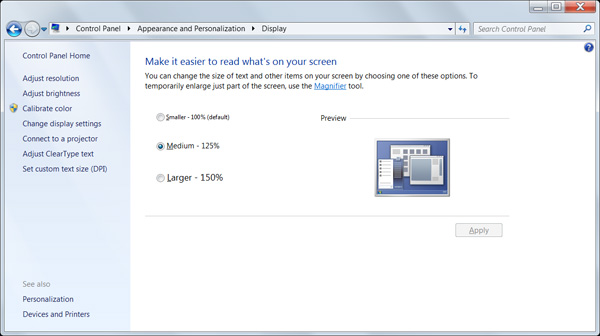
Here's what the default desktop looks like at 125%:
And here are examples of applications that don't behave well with Windows 7's DPI scaling:
In Skype, some text elements are tiny while others are huge. PCMark Vantage is an example of where you see this as well:
Here the scaled text actually can't fit in the area allocated for it, while the rest of the text is entirely too small.
There's not much you can do to work around this today with Windows 7. You're either going to have really small text or have to deal with funny scaling. This is unfortunately a major downside to not controlling the OS layer, ASUS is at the mercy of Microsoft to get scaling for displays with high pixel densities right. Windows 8 should be better in this regard but I ran out of time to try it out on the Zenbook Prime before the embargo lift.




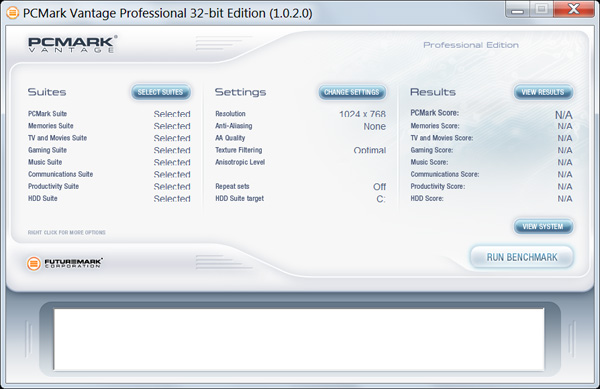








192 Comments
View All Comments
Impulses - Tuesday, May 22, 2012 - link
This is not even close to being a gaming laptop...maniac5999 - Tuesday, May 22, 2012 - link
Quick question, but how decent would the UX32 be at light gaming? (Civ5 on low, SC2 on medium, etc) I'm having some trouble pegging it's performance down, even with the help of Notebookcheck.tipoo - Wednesday, May 23, 2012 - link
The review says says 20 is acceptable for an ultramobile on a slow action game like D3, not that it's a killer gaming experience.ananduser - Wednesday, May 23, 2012 - link
If 20fps is acceptable then 720p resolution is acceptable as well.JarredWalton - Wednesday, May 23, 2012 - link
I've been poking around at Diablo III on another laptop today; to say that it's the greatest experience ever on Intel's HD 4000 would be a stretch, but it's not horrible either. It looks like the worst offender for poor performance on HD 4000 is the shadow setting; at low and 768p I got ~24 FPS for a test sequence, while a bump to 900p with most other detail options at "max" only dropped performance slightly. Turn on high shadows though and you're looking at a drop to about half the frame rate (or 1/3 lower with medium shadows).One thing you have to understand with regards to Diablo III and what constitutes acceptable performance is that it's not a twitch shooter, and the mouse cursor is separate from the frame rate. If you're very tolerant, you could even play with frame rates in the teens, but I'd suggest 20 FPS as the bare minimum. Civilization V is similar in this regard, and it's slow-paced (turn based) enough that even 10 FPS could be livable for some. It all depends on what you're willing to live with. Minimum detail and 768p in Diablo III does look pretty lousy, though -- particularly the lack of shadows, which is one of the biggest boosts to performance.
Now, if you've actually played the game on HD 4000 and want to contribute something to the discussion, that would be fine. Since it sounds like you've never played the game in the first place (at least not on moderate/low-end hardware), though, I'm not sure there's much point in you opining on how "20fps is NOT playable". For most other games, you would be correct, but for Diablo III you're just guessing...wrongly I might add. I played through a whole section with an average of 18FPS and found it acceptable for someone that's not hardcore. (Note that that was with most detail settings maxed at 900p.)
Now I need to go install it on Trinity and a couple other laptops to see how the experience compares. Oh, and FWIW, I'm not sure Diablo III is adding much to the gaming experience that's wildly improved from Diablo II, other than finally supporting higher resolutions. 12 years and this is what they have to show for it. Hmmm....
gorash - Tuesday, May 22, 2012 - link
Soo, ASUS has managed to ship a laptop with a 1080p IPS display without breaking the bank. Why couldn't the other manufacturers do the same?Reflex - Tuesday, May 22, 2012 - link
1) That is the first ultrabook I have ever considered to be interesting enough to consider buying, especially the 13.3" model with nV graphics/1080p LCD2) This is the first Asus laptop I'd consider owning, I've never been impressed with their build quality.
Really I wish it had 8GB as an option, just for longevity's sake(I tend to run a laptop a minimum of 5 years) but at 6GB its probably close enough. Very impressive and reasonably priced too. Want to see the build options and price on the 13.3" version.
Also, can the 24GB built in flash cash be used in conjunction with a hybrid HDD from Seagate? Or will that be an issue? What if you put in a SSD?
dagamer34 - Tuesday, May 22, 2012 - link
There's little point in double caching an SSD.Reflex - Wednesday, May 23, 2012 - link
Correct, but thats the thing, the cache is built in. What happens if you install a SSD? Does it get disabled?Also, there might be some point. This cache is SLC flash, if its utilized extensively it could extend the usable life of the installed SSD by preventing unnecessary writes...
sicofante - Thursday, May 24, 2012 - link
Wouldn't this take 8GB modules? That would make 10GB of RAM, which is pretty future proof for me.If it has 24GB built-in flash, I'd ask for a very big HDD, say 1TB? It would be cheaper than any SSD model and, with those 24GB acting as a cache, fast enough for everyday tasks. Do they offer such a combination?